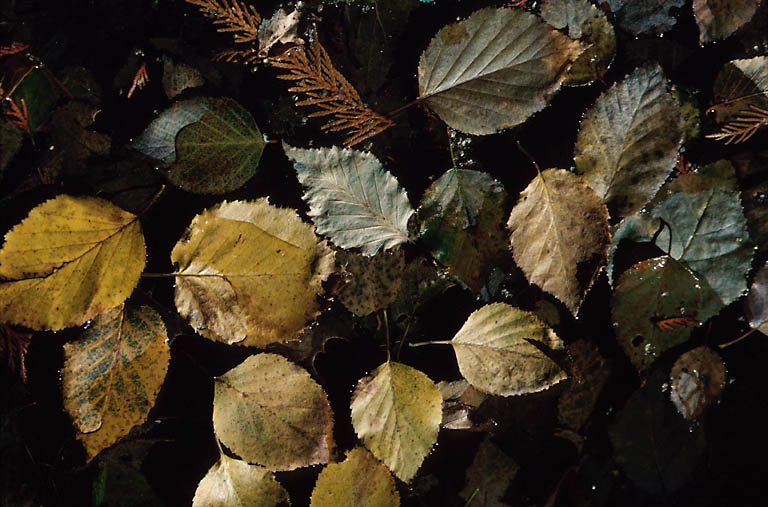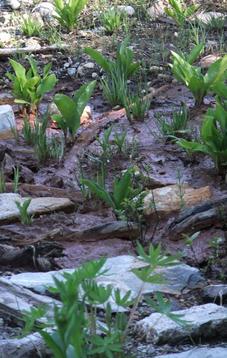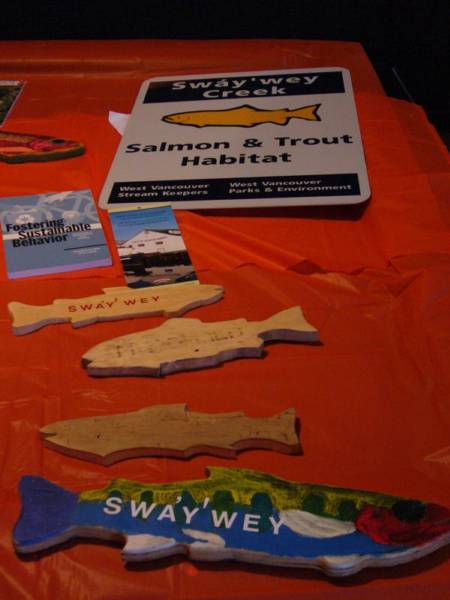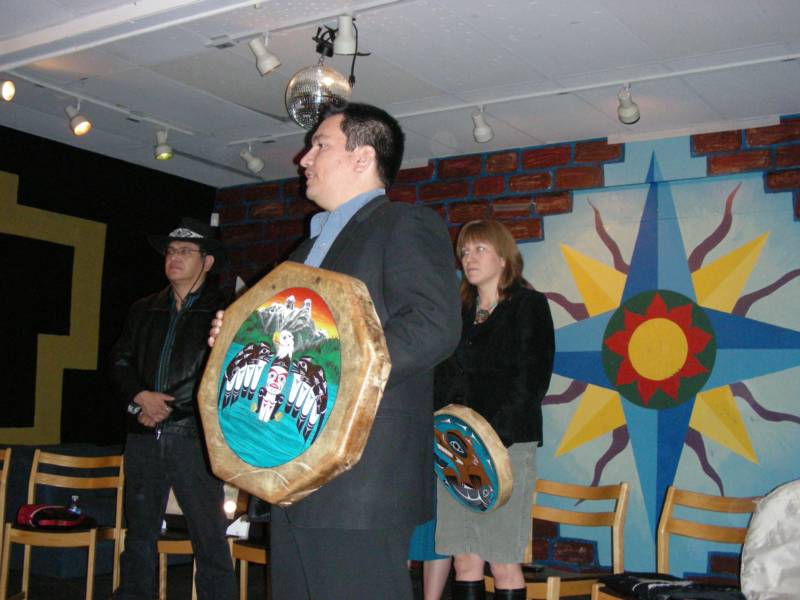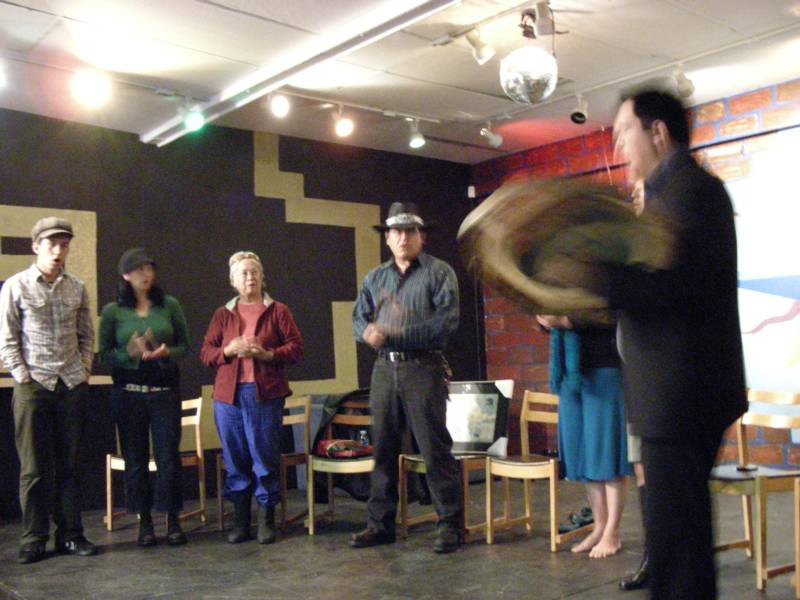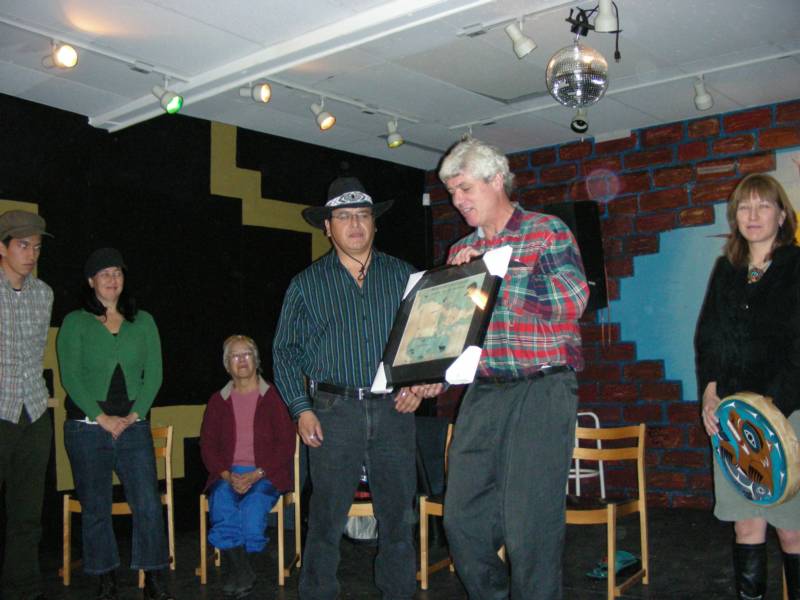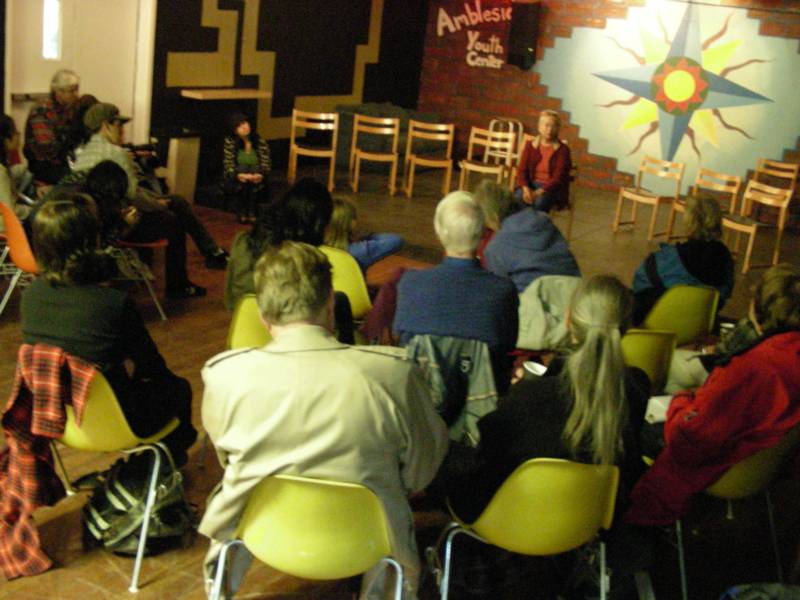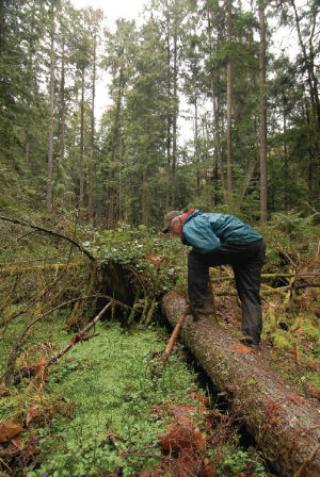

News, Pictures... etc.
The Kermit Factor
By Scott Neufeld - North Shore Outlook - April 03, 2008
The cars speeding past are oblivious to the members of the North Shore Wetland Partners preparing to scamper across a busy stretch of Highway 99.
The air echoes with the sound of rubber gliding over wet asphalt as the group ascends to the wetlands, raincoated figures clinging to the Eagleridge Bluffs. As in the arcade game Frogger, darting across the pulsating highway is the journey’s first obstacle.
Leading the way is Bruce McArthur, a Horseshoe Bay resident who has been walking the Bluffs for 60 years. Soon the sounds of the highway are muffled by a thick green wall of cedar and spruce and the sighs of Larson Creek.
“There was a time where you’d sit and you could hear a leaf fall and hit the ground,” he says as the groaning of heavy machinery begins to fall from above. “All that’s gone forever.”
McArthur walks this trail at least once a week, monitoring the effect of invasive species: ivy, bull frogs, even humans, on the forest’s native inhabitants. As he steps lightly along the damp path, McArthur pulls out any foreign plants he finds, but there’s little he can do about mankind’s most disruptive impacts. McArthur tried to block the highway construction with a protest but a court order later barred him from the trail.
“I had to sign an agreement that I wouldn’t be disruptive anymore,” he said.
McArthur is one of a growing number of volunteers probing the wilds of the North Shore looking for wetlands. In the search for flat land to develop, swamps are drained, marshes are flattened and wildlife is dispersed.
By identifying North Shore wetlands, volunteers hope to encourage government and developers to steer clear of these natural water purifiers. To raise public support, they’re focusing on the public’s affection for frogs – the so-called Kermit Factor.
“I was looking for a silver bullet that would stop the highway,” McArthur said of why he became interested in frogs. “I was looking for something in the trees, but I got tired of looking up.”
McArthur unzips his jacket to reveal a T-shirt bearing a print of the photo proving his amphibian find. Despite this evidence, the provincial government initially denied that frogs lived in the shadow of the highway.
The discovery didn’t stop the highway, but the government agreed to build tunnels so that mammals and amphibians could slip beneath the monolithic mound of rock buttressing the highway.
* * *
Frogs may have outlasted the dinosaurs, but scientists predict that one-third to one-half of the world’s 6,000 known frog species will vanish within the next few decades.
To waken the public to the global plight of amphibians, 2008 was declared the Year of the Frog by zoos and aquariums all over the world. The Vancouver Aquarium is hosting “Frogs Forever?” an exhibit examining the diversity of amphibians and the threats to frogs worldwide.
“There’s really a lot more development going on now,” said aquarium curator Lee Newman. “We’re really starting to encroach on frog habitat.”
Pollution and subtle changes in temperature have also spelled doom for amphibians whose permeable skin makes them particularly vulnerable to ecological fluctuations.
“They’re environmental monitors, the proverbial canary in the coal mine,” Newman said. “When amphibians start disappearing that should concern us from an environmental perspective.”
In order to protect frogs from threats to their habitat, zoos worldwide have launched the Amphibian Ark, a project to keep some amphibians in captivity to protect them from extinction. Newman would not be surprised if B.C.’s frogs wind up in the Ark someday.
“I do think that at some point some measures are going to have to be taken,” he said. “Maybe down the road we’ll have to look at captive breeding.”
Domestic frogs are no more immune to pollution, disease or development than amphibians in other parts of the world. Two of the North Shore’s species: the coastal tailed frog and the red-legged frog are listed as “threatened” species.
* * *
A worker moving rocks with an excavator near Eagleridge Bluffs circles his finger around his ear as if to tell Paul Berlinguette that he’s crazy. Berlinguette is undeterred as he dips into a dank tunnel that will guide large animals under the highway.
Clad in a pylon-orange raincoat, bright yellow pants and a navy tuque, Berlinguette appears out of place among the gentle greens, golds and browns of the forest. The North Shore Wetland keeper is one of the area’s most vocal wetland defenders. Berlinguette has been appearing before local municipal councils to encourage a more sensitive approach to growth.
“I do think we can develop (the North Shore),” he said. “It’s how we develop; we’re clearly not an anti-development group.”
Berlinguette hopes to lead more groups into the North Shore wilderness and teach them the tools of being a wetland keeper. The goal is to have a network of volunteers monitoring activity in the remaining significant wetlands.
“No one is monitoring our local frogs,” he says. “It isn’t a priority for our city, that’s why it’s falling on volunteers to do that.”
For Berlinguette the hope for frogs lies with the next generation, which is why his frog costume has become his second skin. He tours the North Shore, dressed in green, telling kids how to protect the wetlands in their neighbourhoods.
“A lot of kids relate to frogs, I’m not sure if it’s kiss the frog and it turns into a prince or Kermit, but a lot of kids relate to frogs,” he said.
“I used to go to frog ponds when I was a kid in Montreal,” Berlinguette explains. “I’ve always been a frogger I guess.”
By teaching kids about the value of wetlands Berlinguette hopes they’ll avoid some of the bad habits of their parents: including sending dogs to romp through sensitive swamplands or introducing predatory bullfrogs into the wild.
* * *
Traversing McArthur’s narrow trail as it spirals higher like a slender, forested staircase, the wetland keepers step through signs of homeless camps, abandoned mountain biker trails, trees stripped of their bark and other evidence of human encroachment. Out here any human activity has a consequence.
When the keepers arrive at the “flagship” of the Bluffs’ wetlands, McArthur notes the unusual abundance of emerald-tinted algae. He’s surprised at how the highway work site has crept closer and is now merging with the wetland.
In this area, at this time of year frogs are virtually impossible to spot and even more difficult to hear. The red-legged frog saves its voice exclusively for underwater mating calls while the coastal tailed frog, another blue-listed North Shore native, has no vocal cords at all.
“You’ll hear a plop and then you’ve just gotta look for them,” McArthur said of the North Shore’s speechless frogs. “They’re very susceptible (to predators) out in the wetlands, that’s why they’re more likely to come out only at night.”
It’s unclear what effect the highway will have on the surrounding wilderness. But McArthur is setting up photo point monitoring in the area to allow biologists to track the changes over decades. Fifty years from now, scientists will be able to compare photos taken from the exact same spot at different times.
Berlinguette hopes to expand the idea to keep tabs on other threatened wetlands on the North Shore.
In the meantime, he’s appealing to the public to inform the wetland keepers whenever they spot frogs.
“We certainly want to know where the bullfrogs are because they eat the red-legged frog,” said Berlinguette. “We don’t want to scorn anyone for their past mistakes we just want to protect our native frogs.”
For more information on the North Shore Wetland Partners visit nswetlandpartners.com.
© Copyright Black Press. All rights reserved.
West Vancouver -
Heritage Week 2007 honours handed out
by Caroline Skelton, 



North Shore News
Published: Wednesday, February 20, 2008
It can be a tough and unheralded job protecting community heritage.
But this week, the City of North Vancouver, and the Districts of North Vancouver and West Vancouver are working to honour those who preserve North Shore heritage.
In celebration of Heritage Week, running Feb. 18-24...
...The recipients of the District of West Vancouver's Heritage Achievement Awards, which were presented Feb. 18, are as follows...
...Paul Berlinguette (North Shore Wetland Partners) and Randall Lewis (environmental co-ordinator for the Squamish Nation), for their work in restoring a West Vancouver Creek (formerly Pound Creek) to its Skwxwu7mesh name, Swáy'wey...
© North Shore News 2008
© North Shore News 2008
Environmentalists lobby for wetland preservation
Raphael Lopoukhine, 


 Special To North Shore NewsPublished: Friday, February 01, 2008
Special To North Shore NewsPublished: Friday, February 01, 2008
2008 may be the year of the rat on the Chinese zodiac calendar but for conservation groups, including the North Shore Wetland Partners, it's the year of the frog.
The effort, spearheaded by the Association of Zoos and Aquariums, has chosen the frog to draw attention to a world wide amphibian extinction crisis. The rapid drop first documented in a comprehensive world survey in 2004 demonstrated that as many as 122 species of frogs, toads, and salamanders have disappeared since 1980, and that 1,900 species were in danger of becoming extinct from the cumulative effects of deforestation, habitat loss, pollution and climate change.
Amphibians are often referred to as the "canary in the coal mine" because their health is a barometer of the health of the entire ecosystem. On the North Shore, their primary wetland habitat has mostly disappeared, said Monica Craver of the North Shore Wetland Partners in a Jan. 21 presentation to District of North Vancouver council. As a result, said Craver, they are found more often than not in drainage ditches from here to Whistler.
The wetland partners are currently developing global positioning system (GPS) maps of current viable North Shore amphibian habitat.
It was suggested by district staff that they collaborate to input their data into the district's extensive geographic information systems database to inform planning and development decisions.
Currently, the district and the wetland partners collaborate in protecting sensitive habitat, including restoration, path removal, fencing and posting signs, but more work is needed to counteract the habitat fragmentation and human ignorance, said Craver. Without corridors of connectivity the frog populations will become inbred, loosing their genetic diversity and then their populations can collapse.
"Our wetlands are irreplaceable anywhere on the North Shore. Especially since we have a very rich, natural area. But slowly our wetlands are disappearing," said Craver.
© North Shore News 2008
Renaming creek links past and future
Swáy'wey Creek once fed a marsh and took Squamish to burial ground
Munisha Tumato
North Shore News
Sunday, November 04, 2007
IF you walk west along Marine Drivepast all of Park Royal Shopping Centre's southern sprawl, and look to your left into the ditch that lines the soccer fields, you will see what remains of
Swáy'wey Creek.
It's not what it once was.
Co-existing with a mall and a busy street is not easy for a creek. Somewhere along the way, as a community built up around it, it was renamed Pound Creek and today it is classified, rather unromantically, as an open storm drain.
But for the people gathered at the Ambleside Youth Centre, it is much more. Members of the North Shore Wetland Partners, the Squamish Nation and the West Vancouver community gathered on Oct. 19 to recognize the creek as it was known to the nations that lived on its edges and around the wetland and lagoon that it runs into.
Before it was an open storm drain, before it lived next door to malls and roads and soccer fields it was Swáy'wey (pronounced Shwey-wee), which loosely translates to "aboriginal smelting lagoon" according to Paul Berlinguette, member of the North Shore Wetland Partners.
The creek ran into what was once a large marshy area, a wetland full of a diversity of wildlife including fish and smelts, beavers, turtles, ducks, geese and swans, and the green herring which is incredibly rare this far north, said Berlinguette.
"I grew up here, played here, fished here, canoed here," and it's heartbreaking, said Berlinguette, to see the wetlands wildlife covered in oil.
"Park Royal was once lush with marshes and sloughs," said Squamish Chief Ian Campbell. "This was Swáy'wey -- not just some little creek." The creek and lagoon once provided the villages in the area access by canoe to a burial ground that was behind Park Royal towers, said Campbell.
According to a Vancouver Sun article from 1940, the lagoon was also home to John "Navvy Jack" Thomas whose family lived in a "neat, white house on the west side of the creek's delta." Navvy Jack, a gravel excavator from Wales, was the first European settler in the area. He was the grandfather of the late Chief Dan George of the Burrard Inlet Tsleil-Waututh Nation.
The wetlands continue to survive, despite the presence of a mall in its midst. A small miracle, said Cease Wyss, ethnobotanist and member of the Squamish Nation, but an adequate metaphor. "Our spirit is strong," said Wyss whose traditional name is T'uy'tanat. "We belong here." The creek marks the boundary between the district of West Vancouver and the Squamish Nation.
Its aches are numerous. "It is the worst creek on the North Shore," said Berlinguette. Seven years ago with a team of volunteers -- comprised largely at first of family and friends putting in their weekends hours -- Berlinguette began working on the creek, trying to clean it up and restore it to its former self.
According to a year-long study of the wetlands conducted by a group of UBC environmental science students, the creek is in devastatingly poor shape. Swáy'wey Creek and Ambleside Lagoon is a fairly typical example of what happens in an urbanized watershed," said Julie Wilson, one of the study's authors.
The study compared the levels of pollutants, like sediments and heavy metals such as lead and copper, with the standard levels in the Canadian sediment quality guide and found the levels in the creek and lagoon to be exceedingly high. Much of the oil and heavy metals in the water comes from Marine Drive and degrading car parts, said Wilson.
The study also looked at some of the smaller organisms making up the base of the food chain in the creek and found that they were of a very hardy variety -- the kinds of organisms that can survive high levels of toxicity and heavy metal pollution. There was no sign whatsoever, said Wilson, of the more sensitive organisms that live in pristine streams.
The whole system is classified between fairly poor and very poor health," said Wilson.
The water is slick with oil from car effluents, said Berlinguette, but also from cooking oil from the 32 oil tanks the fire department found in the watershed on Sentinel Hill.
Still, it is one of the few ecosystems that has survived rapid urbanization intact, said Wyss, whose concern as an ethnobotanist is "keeping our medicines growing where they belong."
Although "Aboriginal smelting lagoon" is the original meaning of the creek's name, the significance of Swáy'wey is lost in the translation. The renaming of the river represents much more to Dustin Rivers of the Squamish Nation.
Rivers, 18, has taken on the critical task of learning Skwxwu7mesh. He estimates that there are approximately 15 people left who speak the language of his ancestors.
There is no times to simply learn, so Rivers teaches as well. "I'm only three steps ahead of the people I'm teaching," he laughs.
Like Swáy'wey, Skwxwu7mesh has suffered the effects of foreign invasion. As is the case with many First Nations languages, the responsibility for revival rests in the hands of the youth, many of whose parents lost their languages to the tongue of a strap in residential schools.
For 60 years, said Squamish Elder Barbara Wyss, speaking Skwxwu7mesh was strictly forbidden by the federal government and the Catholic church.
Rivers says he grew up during a time of cultural revival. He recalls living with his grandmother, who wouldn't let him play after school until he had listened to a tape of their people's traditional songs. A residential school survivor, Rivers' grandmother didn't know the songs herself but felt it imperative that her grandson learn them.
"Having an identity, knowing who you were -- it gives you a confidence," said Rivers, for whom the natural progression from this budding sense of cultural identity was learning his language.
At its lowest, the number of Skwxwu7mesh speakers fell to around four or five, said Barbara Wyss. But that trend is slowly reversing now thanks to the Skwxwu7mesh classes available in schools, and to the initiative of the youth.
Restoring Swáy'wey creek will require a similar initiative. Wilson and Berlinguette say the municipality has taken a few steps towards restoring the creek. They've started digging a large detention pond, said Wilson, which is useful for collecting some of the sediments and toxic metals before the water enters the stream.
It's a fairly small system but it receives storm water from large watersheds that hold storm water from residential areas and the mall, said Wilson. A bioswail will absorb some of the excess rainwater, said Berlinguette, and an oil-water separator will hopefully remove some of the nasty oil washing from Marine Drive.
There is a long way to go, but most of those at the Ambleside Youth Centre feel that this is a promising beginning. During the unveiling of the new Swáy'wey Creek sign, West Vancouver Mayor Pam Goldsmith-Jones described it as a day to mark a connection to "roots we didn't even know we had."
For Berlinguette it's the first Skwxwu7mesh renaming of many he hopes to spearhead in the area.
And for Cease Wyss, it is a matter of preservation, healing and rebirth. "It is much more," she says, "than just a little creek I'm trying to save."
© North Shore News 2007
